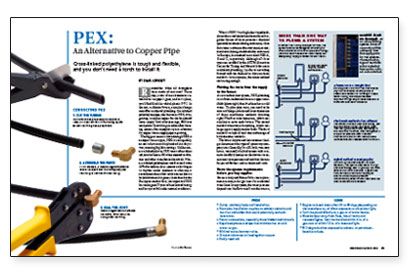PEX: an Alternative to Copper Pipe
Cross-linked polyethylene is tough and flexible, and you don't need a torch to install it.

Synopsis: A plumber examines the pros and cons of PEX (cross-linked polyethylene) plumbing systems, and explains the special planning, tools, and materials that are needed to design and install them. Included is a sidebar that discusses alternative methods for plumbing a residential PEX system.
Remember when all drainpipes were made of cast iron? These days, a tour of most basements reveals that iron pipe is gone, and in its place, you’ll find black (or white) plastic: PVC. In the not-so-distant future, a similar change may affect residential plumbing: Cross-linked polyethylene pipe, also known as PEX, is beginning to replace copper for the household water supply. Until a few years ago, PEX was used primarily as tubing in radiant-floor heating systems, but its popularity as a substitute for copper water-supply pipe is growing.
The biggest reason is that although PEX is as expensive as copper, PEX installs quickly; an entire house can be plumbed in a day or two, meaning big labor savings. Unlike non cross-linked plastics, PEX won’t soften when subjected to heat or fail when exposed to chlorine and other waterborne chemicals. Non cross-linked polybutylene was first used in the 1970s for radiant-floor systems until it began to rupture under exposure to chlorine; it caused more than a few new concrete slabs to be jackhammered to pieces. Introduced to the European market first, the improved PEX has undergone 30 years of accelerated testing and has yet to fail under normal conditions.
What is PEX? It’s a high-density polyethylene whose molecules have been chained together by one of three processes: chemical (peroxide treatment during extrusion); silane (hot-water treatment after extrusion); or electron beam (tubing irradiated after extrusion). In Europe, the methods are called PEX A, B and C, respectively. Although all three types are certified by the ASTM (American Society for Testing and Materials) for use in residential plumbing, I prefer to use tubing formed with the chemical or electron-beam methods. In my opinion, the silane method isn’t strong enough.
Plotting the route from the supply to the faucet
As in a radiant-heat system, PEX plumbing is run from multi-outlet brass or copper manifolds that distribute hot or cold water. To plan pipe runs, you need to be aware of design criteria and must choose one of three installation methods. The first is the home run, which uses one line to serve each fixture. The second method is known as branching, which uses larger pipe to supply smaller feeds. The third method is a hybrid and takes advantage of both the other methods.
The house’s layout and the customer’s budget determine what type of system my company uses. Generally, for a 2 1⁄2-bath, two-story house, we install a hybrid system with a remote manifold, home-run the showers to ensure consistent pressure and combine the runs for paired fixtures such as toilets and sinks.
Know the system requirements before you buy supplies
Pressure drop and fixture flow-rate requirements are major design issues for residential water lines. In any system, the water pressure depends on the flow rate from the source, whether a well or a city water line. Gravity and pipe diameter reduce water flow to a fixture; the correct pipe diameter should overcome both obstacles and supply the necessary amount. Because of all the variables involved, sizing pipe is a somewhat complicated subject. For more information, consult the pipe manufacturers’ pressure-drop charts or the appropriate plumbing codebook.
For more photos, drawings, and details, click the View PDF button below:
Fine Homebuilding Recommended Products
Fine Homebuilding receives a commission for items purchased through links on this site, including Amazon Associates and other affiliate advertising programs.

Smart String Line

100-ft. Tape Measure

Plate Level


























